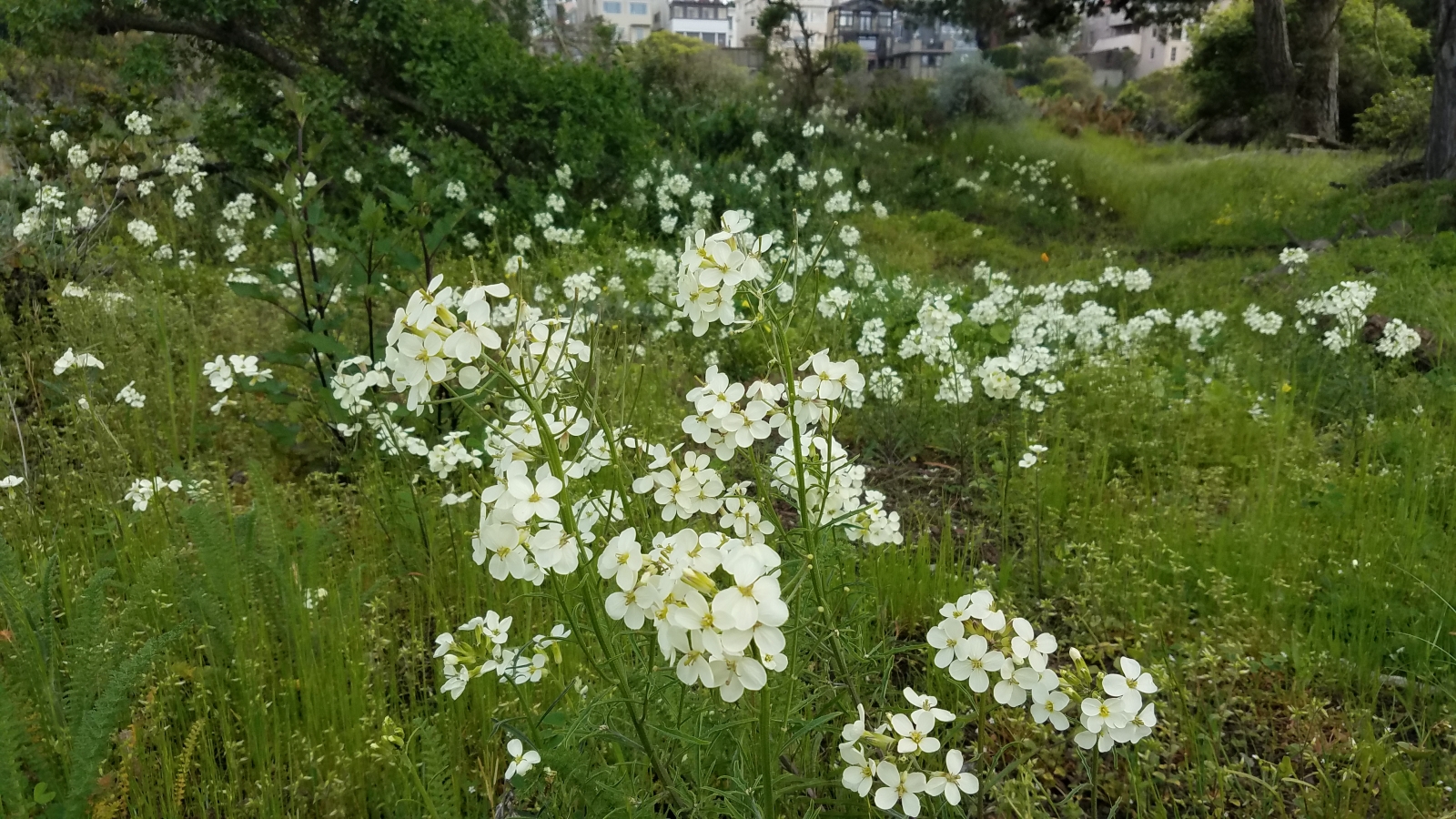While people connect easily with the spectacular recovery of the American bald eagle, California elephant seal, or other endangered wildlife, they may be less aware of the wildflowers underfoot or the subtly fragrant shrublands along the trail. Due to San Francisco's unique geology, extent of urban development, and biogeographic isolation, the city harbors rare and fragile native plant communities.

These special ecological areas harbor 17 rare & endangered plant species (PDF), as can be seen listed below. Most of these endangered members of the San Francisco flora grow nowhere else but here in the Bay Area, and some only in the City itself! The Presidio's watersheds harbor 5 federally-listed endangered plant species in their dunes and serpentine soils. San Francisco is truly an ecological refuge for these rare plants that need our very special micro-habitats to survive, and which are vital members of our City's biological diversity.
Coast Rock Cress (Arabis blepharophylla)
This rare, native perennial species of the Mustard Family grows up to 12 inches in height with showy, fragrant, pink to purple four-petaled flowers with white centers and thin, hairy stems from a rosette of leaves. It is uncommon in the wild but is often grown as an attractive, sweet-scented flowering garden plant.
Franciscan Manzanita (Arctostaphylos franciscana)
Thought to be extinct in the wild for nearly 70 years, a single wild plant of Franciscan manzanita was discovered in October of 2009 in the Presidio.
Presidio Manzanita (Arctostaphylos montana ssp. Ravenii)
Known from only one extant native occurrence at the Presidio; plants there belong to a single clone. Five of six historical occurrences extirpated by urbanization. Currently threatened by non-native plants, encroachment of native shrubs, and branch dieback due to fungal pathogen.
San Francisco Bay Spineflower (Chorizanthe cuspidata var. Cuspidate)
This rare, native annual species has small, hairy, white to rose colored flowers. The stem is soft and hairy and often prostrate. San Francisco Spineflower is an early dune colonizer, dependent on having open sandy habitat for establishment.
Franciscan Thistle (Cirsium andrewsii)
This robust thistle stands up to six feet tall and the stems can reach two inches in diameter. The stems and upper surfaces of the leaves are thinly cobwebby, as are the leaf undersides. The rosy purple flower heads are also densely cobwebby.
Presidio Clarkia (Clarkia franciscana)
Growing only in the Presidio and in the East Bay hills, it is known from fewer than five occurrences. This rare and endangered, native annual species is threatened by army activities, vehicles, urbanization, and non-native plants.
San Francisco Collinsia (Collinsia multicolor)
Also known as Franciscan blue-eyed Mary, they form a series of whorls, one stacked on top of the other, forming a very showy inflorescence as much as ten inches high. Threatened by non-native plants and urbanization.
San Francisco Wallflower (Erysimum franciscanum)
This rare, native, perennial species of the Mustard Family has cream colored flowers with 4 petals. The linear leaves are broad with sharp, deep teeth on singular or few-branching stems that stand 2-18 inches tall. It has no formal state or federal status as a protected species.
Blue Coast Gilia (Gilia capitata ssp. Chamissonis)
This native, annual species is endemic to the sand dunes of California's central coast and one of the Presidio's rare plants. Its clusters of small flowers are bright blue-violet. Threatened by urbanization, recreational development, and non-native plants. Possibly threatened by trampling.
Hairy/San Francisco Gumplant (Grindelia hirsutula)
A species of flowering plant in the daisy family. Previously on List 1B. Threatened by coastal development and non-native plants. Used by the Pomo as a sedative, antispasmodic, expectorant, to treat poison-ivy, and as a tea substitute.
Marin Western/Dwarf Flax (Hesperolinon congestum)
Populations of this species are declining, and the species may soon be lost from the Presidio. It is known from only roughly 15 locations in Marin, San Francisco, and San Mateo counties. Endemic to California and endangered.
Kellogg' Horkelia (Horkelia cuneata var. sericea)
Threatened by coastal development. Historical occurrences need field surveys. Occurrence from the Crocker Hills probably last remaining location in S.F. Bay; remaining plants less distinct from ssp. cuneata than those formerly occurring near San Francisco.
Coast Iris (Iris longipetala)
This uncommon native is restricted to swales and moist areas in coastal grasslands from San Francisco to Monterey. Bluish-green evergreen blades form erect clumps one foot to 20 inches tall. Threatened by development and trampling.
San Francisco Lessingia (Lessingia germanorum)
This rare and endangered, native annual can have from 1 to 80 flowers. Range limited to San Francisco Bay Area. Known from only 4 occurrences at the Presidio and one on San Bruno Mtn. Populations increasing 1994-1998 due to restoration efforts. Much reduced by urbanization; also threatened by trampling, sand quarrying, and non-native plants.
Michael's Rein Orchid (Piperia michaelii)
An uncommon species of orchid. It is endemic to California, where it is known from the coastal plains, hills, and mountains, and the Sierra Nevada foothills. It can be found in varied habitat, including scrub, woodland, and forest.
San Francisco Campion (Silene verecunda ssp. verecunda)
This rare, native perennial species has bell-shaped flowers with ten veined, pink to rose petals, and long, tapering, hairy leaves. The San Francisco Campion is a federal candidate for being listed as an endangered species. Threatened by development and non-native plants.
California Seablite (Suaeda californica)
Formerly more widespread in San Francisco Bay Area, where now nearly extirpated by development; currently only known from fragmented populations in SF Bay Area and Morro Bay. Remains from adobe bricks indicate plant may once have occurred along the Petaluma River. Threatened by development, recreational activities, erosion, non-native plants, and alteration of marsh habitat.